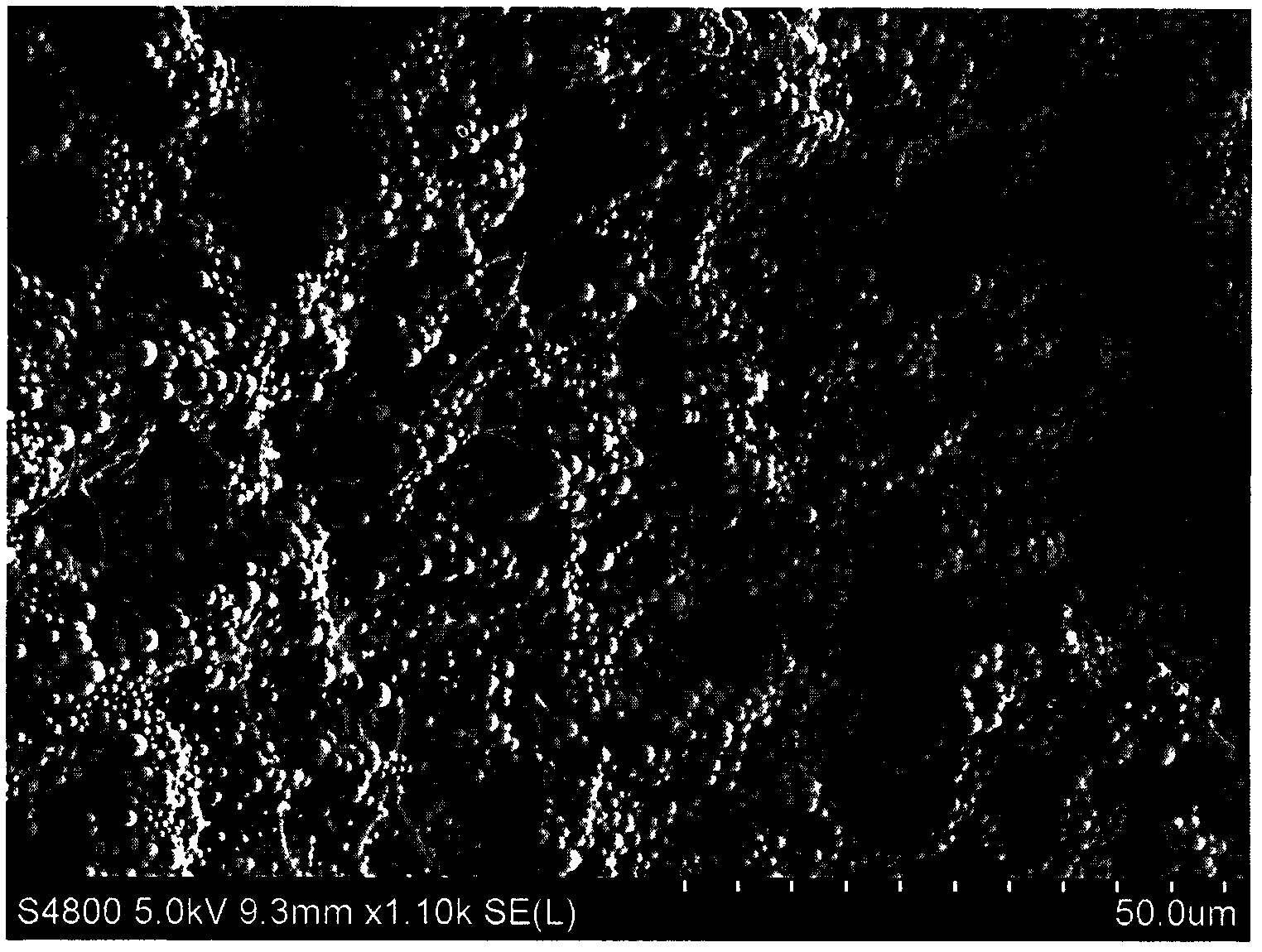Biomass cellulose porous composite diaphragm used for lithium ion secondary cell
A biomass and composite membrane technology, applied in battery pack parts, circuits, electrical components, etc., to achieve the effects of uniform pore structure and distribution, convenient preparation and high heat resistance
- Summary
- Abstract
- Description
- Claims
- Application Information
AI Technical Summary
Problems solved by technology
Method used
Image
Examples
Embodiment 1
[0023] 3.0 g of cellulose and 8.0 g of lithium chloride were added to 89.0 g of N,N-dimethylacetamide and stirred at 25° C. for 24 hours to slowly dissolve to obtain a uniform cellulose solution (3% by mass). Then store the cellulose solution in a refrigerator at 0-5°C. Another 3.0 ml of cellulose solution was taken out for electrospinning, the needle diameter was 1.6 mm, the spinning voltage was 25 kV, the height from the needle tip to the receiving plate was 10 cm, and electrospinning was performed for 4 hours to obtain cellulose with a thickness of 85 microns. nanofibrous membrane. After soaking the film in 3% sodium alginate aqueous solution for 10 minutes, take it out, and after drying in the air, place the film in a roller press with a pressure of 2 MPa for 2 minutes to obtain a composite cellulose nanocomposite with a thickness of 40 microns. Fiber membrane.
Embodiment 2
[0025] Add 5.0 g of cellulose to 95 g of N-methylmorpholine-N-oxide and stir at 25° C. for 3 hours to slowly dissolve to obtain a uniform cellulose solution (5% by mass). Then store the cellulose solution in a refrigerator at 0-5°C. Another 3.0 ml of cellulose solution was taken out for electrospinning, the needle diameter was 1.6 mm, the spinning voltage was 25 kV, the height from the needle tip to the receiving plate was 10 cm, and electrospinning was performed for 4 hours to obtain cellulose with a thickness of 85 microns. nanofibrous membrane. The membrane was soaked in a DMF solution with 2.7% silica nanoparticles and 0.3% vinylidene fluoride and hexafluoropropylene copolymer dissolved in it for 10 minutes. After drying, the membrane was placed on a roller with a pressure of 2 MPa. Stay in the press for 2 minutes to obtain a regenerated cellulose nanofiber membrane with a thickness of 40 microns.
Embodiment 3
[0027] Add 5.0 g of cellulose to 95 g of N-methylmorpholine-N-oxide and stir at 25° C. for 3 hours to slowly dissolve to obtain a uniform cellulose solution (5% by mass). Then store the cellulose solution in a refrigerator at 0-5°C. Another 3.0 ml of cellulose solution was taken out for electrospinning, the needle diameter was 1.6 mm, the spinning voltage was 25 kV, the height from the needle tip to the receiving plate was 10 cm, and electrospinning was performed for 4 hours to obtain cellulose with a thickness of 85 microns. nanofibrous membrane. The film was soaked in a DMF solution of 2.4% silica nanoparticles and 0.6% polyetherimide (Ultem1000) for 10 minutes, taken out, and after drying, the film was placed on a roller with a pressure of 2 MPa Stay in the press for 2 minutes to obtain a regenerated cellulose nanofiber membrane with a thickness of 40 microns.
PUM
| Property | Measurement | Unit |
|---|---|---|
| Thickness | aaaaa | aaaaa |
| Thickness | aaaaa | aaaaa |
| Quality score | aaaaa | aaaaa |
Abstract
Description
Claims
Application Information
 Login to View More
Login to View More - R&D
- Intellectual Property
- Life Sciences
- Materials
- Tech Scout
- Unparalleled Data Quality
- Higher Quality Content
- 60% Fewer Hallucinations
Browse by: Latest US Patents, China's latest patents, Technical Efficacy Thesaurus, Application Domain, Technology Topic, Popular Technical Reports.
© 2025 PatSnap. All rights reserved.Legal|Privacy policy|Modern Slavery Act Transparency Statement|Sitemap|About US| Contact US: help@patsnap.com



